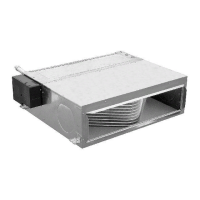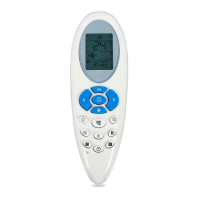4-7 62-10630
4.15 ADJUSTING THE COMPRESSOR PRESSURE
REGULATING VALVE (CPR)
When adjusting the compressor pressure regulating
valve (CPR) (see Figure 4-6.), the unit must be running
in heating or defrost mode. This will ensure a suction
pressure above the proper CPR setting. To adjust the
CPR valve, proceed as follows :
a. Install a gauge on the suction line .
b. Remove cap from CPR valve.
c. With an 8 mm Allen wrench, loosen the jam nut.
d. Usingthe8mmAllenwrench,adjust thesetscrew.To
raise the suction pressure turn the set screw clock-
wise; to lower the suction pressure, turn counter-
clockwise. Refer to paragraph 1.3 for CPR valve set-
ting.
e. When the setting has been adjusted, tighten the jam
nut securely against the set screw. This will prevent
any movement of the set screw due to vibrations in
the unit. Replace the cap.
4.16 THERMOSTATIC EXPANSION VALVE
The thermal expansion valve is an automatic device
which maintains constant superheat of the refrigerant
gas leaving the evaporator regardless of suction
pressure. The valve functions are: (a) automatic
response of refrigerant flow to match the evaporator
load and (b) prevention of liquid refrigerant entering the
compressor . In addition, this valve is of the Maximum
Operating Pressure type. Valves with MOP, will limit the
riseof suctionpressureaboveset point inorder toavoid
overloading of the compressor.
Unless the valve is defective, it requires noadjustment,
but maintenance must be done every year in order to
clean the orifice strainer. Refer to paragraph 4.6.
4.16.1 Replacing expansion valve
a. Pump the unit down. Refer to paragraph 4.7.2.
b. Remove insulation from expansion valve bulb and
then remove bulb from suction line.
c. Looseninlet nutandunbraze equalizerlineandoutlet
line from expansion valve.
d. The thermal bulb is located below the center of the
suction line. This area must be clean to ensure posi-
tive bulb contact. Strap thermal bulb to suction line
and insulate both.
e. Braze the equalizer tubes to expansion valve.
f. Evacuate, dehydrate and recharge unit.
g. Check superheat (refer to paragraph 1.3).
4.16.2 Measuring superheat
a. Remove insulation from expansion valve bulb and
suction line. See Figure 4-7.
b. Loosen one TXV bulb clamp and make sure area un-
der clamp (above TXV bulb) is clean.
c. Place thermocouple above (parallel to) the TXV bulb
and then secure loosened clamp making sure both
bulbs are firmly secured to suction line as shown in
Figure 4-7.
d. Connectanaccurate gaugetothe¼”porton thesuc-
tion service valve.
e. Rununituntilstabilizedat --4_F(-20_C)boxtempera-
ture.
f. Fromthetemperature/pressurechart (Table 4-3),de-
termine the saturation temperature corresponding to
the evaporator outlet pressure.
g. Notethetemperatureof thesuctiongas at theexpan-
sion valve bulb.
h. Subtract the saturation temperature determined in
Step f. from the average temperature measured in
Step g.. Thedifferenceisthesuperheatofthesuction
gas. Refer to paragraph 1.3 for superheat setting.
i. If required adjust superheat by turning the adjusting
screw located under the cap on the side of the valve.
1
2
3
4
5
1. Suction Line
(end view)
2. TXV Bulb Clamp
3. Thermocouple
4. TXV Bulb
5. Nut and Bolt (Clamp)
Figure 4-7. Thermostatic Expansion Valve Bulb
And Thermocouple
4.17 MICROPROCESSOR
Although there is less danger of electrical static
discharge (ESD) damage in the outdoor environment,
where the processor is likely to be handled, proper
board handling techniques should be stressed. Boards
should always be handled by their edges, in much the
samewayonewouldhandleaphotograph.Thisnotonly
precludes the possibility of ESD damage, but also
lowers the possibility of physical damage to the
electronic components. Although the microprocessor
boards are fairly rugged when assembled, they are
more fragile when separated and should always be
handled carefully.
When welding is required on the unit frame, or on the
frontareaofthetrailer,ALLwiringtothemicroprocessor
MUST bedisconnected. When weldingis performed on
other areas of the truck and van, the welder ground
connectionMUSTbeincloseproximitytotheareabeing
welded.Itisalsoagoodpractice toremove bothbattery
cables before welding on either the unit frame or the
truck to prevent possible damage to other components
such as the alternator and voltage regulator.

